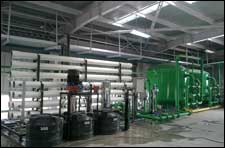 Industrial use of water is currently around 8 per cent of the total freshwater available and is expected to go up to 10 per cent by 2025. R.R. Prasad, Business Head – Water Projects, Eureka Forbes, elaborates on technologies associated with wastewater management and on the importance of choosing the appropriate technology for the same.
Industrial use of water is currently around 8 per cent of the total freshwater available and is expected to go up to 10 per cent by 2025. R.R. Prasad, Business Head – Water Projects, Eureka Forbes, elaborates on technologies associated with wastewater management and on the importance of choosing the appropriate technology for the same.
Water is a vital resource for the sustenance of human life and activities. Rapid urbanisation, climate change and growing needs have put ever-increasing pressure on freshwater resources. The Indian water scenario is grim and is expected to be water stressed by 2025 as per a recent report of UN. The industrial usage of water is presently pegged at around 8 per cent of the total freshwater available and is expected to go up to 10 per cent by 2025. Industries also generate large amount wastewater as a consequence of the processes employed. Short supply of water, especially to industries, would have a negative impact on the economic growth rate and hence water recycling has become imperative for their sustenance and growth.
Burgeoning cities have created greater demand for supply of water and also generate a large amount of wastewater which, if discharged without any form of treatment into water bodies, may harm the aquatic life and the environment. Hence, wastewater management has become the need of the hour.
Wastewater management may be defined as the processes adopted to manage effluent water either for reduction of pollution in water before discharge to water bodies or for its reuse. Thus, wastewater management is not only a science but also an art. Numerous technologies are available for wastewater treatment and choosing the appropriate technology is a very important aspect of wastewater management.
Municipal wastewater treatment processes involve primary treatment processes which include physical-chemical processes such as sedimentation, flocculation etc., secondary treatment processes which include biological units such as activated sludge or trickling filters, and tertiary treatment which includes processes for disinfection. Wastewater treatment for industrial applications may involve treatment processes specifically designed to remove contaminants that are present in industrial effluents. Examples of typical industrial wastewater treatment include sorption, membrane filtration, precipitation and pH adjustment. There has been a constant endeavour amongst the water professionals to innovate new technologies with the basic aim of reducing the reaction time, plant footprints and cost of treatment. The present trend is the use of Membrane Bio Reactors (MBR) and Zero Liquid Discharge (ZLD) systems.
 The major innovations in wastewater management are:
The major innovations in wastewater management are:
Decentralised treatment plants: These are treatment plants specific to small communities, condominiums and buildings and are not connected to the main wastewater treatment system. Such designs permit the community to utilise the wastewater by recycling and help in conservation.
Satellite water reclamation plants: They remove flow from nearby sewers to produce reclaimed water close to the use area and thus prevent the laying of pipelines and pumping systems to return the reclaimed water to the use areas from central treatment plants.
Membrane separation technologies: It involves the separation of liquids from solids using ultrafiltration, microfiltration or reverse osmosis technologies. The water produced is so clean that it is potable, though most of the applications of reclaimed water are for grey water and irrigation use. These technologies are becoming increasingly popular as the cost of the membranes is showing a downward trend.
Biodiesel from fats, oil and grease in wastewater: Fats, oil and greases are collected from wastewater and converted to biodiesel through esterification and hydrogenation. This is becoming increasingly popular in Europe and Canada.
Electricity and heat from cogeneration: Biogas fuelled cogeneration systems allows wastewater facilities to utilise energy from treatment process itself. Cogeneration produces electricity and hot water from biogas, a naturally occurring byproduct of sludge dewatering. The electricity produced can be used to supply power to anaerobic digesters in the plant thereby offsetting electricity purchases.
Electricity from sewage powered fuel cells: Methane from sludge dewatering plants can be converted in biogas or to hydrogen which can be used in direct fuel cells.
Water source heat pumps: Water-source heat pumps are being used in Japan to extract residual heat energy from wastewater, after treatment and before discharge by outfall. Similar heat extraction technology is now developing for extracting heat from wastewater in sewer pipelines. Wastewater temperatures average around 16 degrees Celsius. This heat can be used as an energy resource.
Apart from above innovations, wastewater management also includes processes and strategies for their reuse so as to reduce the dependency for freshwater supplies. The major shift seen in the recent past is the adoption of ‘zero liquid’ discharge systems wherein the wastewater treated is reused and not discharged to public sewers or water bodies. The technologies employed include ultrafiltration, reverse osmosis and evaporation. Further, considerable work is being done the world over to develop more effective materials used in the technologies with aim of reducing costs and improve treated water parameters and also improve the efficiency of the existing technologies by adopting different configurations.
To conclude, technologies associated with wastewater management are constantly evolving and are the main focus of a large number of scientists, technologists and water professionals the world over. It has been their constant endeavour to provide wastewater treatment solutions meeting the exacting requirements of each segment, be it municipal wastewater or industrial wastewater. Wastewater management is thus being viewed as an essential activity in environmental protection and water conservation.












the technology of wastewater treatment and subsequent conversion of sludge into natural fertilizer is able even removes mercury from the effluent. But it is not able to break through the bureaucracy and environmental talkers monopolists bulky and expensive equipment.))) Successfully stolen the laboratory sample are trying to use. While smaller units operate in Ukraine and Russia — where the purity of the water so as not needed..
I’ve been really interested in these ideas, especially the “Biodiesel from fats” idea. It seems that it is really groundbreaking…